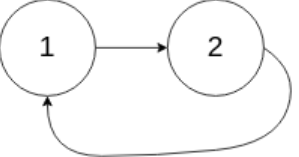I Problem
Given head, the head of a linked list, determine if the linked list has a cycle in it.
There is a cycle in a linked list if there is some node in the list that can be reached again by continuously following the next pointer.
Internally, pos is used to denote the index of the node that tail's next pointer is connected to. Note that pos is not passed as a parameter.
Return true if there is a cycle in the linked list. Otherwise, return false.
Example 1
Input: head = [3, 2, 0, -4], pos = 1
Output: true
Explanation: There is a cycle in the linked list, where the tail connects to the 1st node (0-indexed).
Example 2
Input: head = [1, 2], pos = 0
Output: true
Explanation: There is a cycle in the linked list, where the tail connects to the 0th node.
Example 3
Input: head = [1], pos = -1
Output: false
Explanation: There is no cycle in the linked list.
Constraints
- The number of the nodes in the list is in the range
[0, 10⁴]. -10⁵ <= Node.val <= 10⁵posis-1or a valid index in the linked-list.
Follow up
Can you solve it using O(1) (i.e. constant) memory?
Related Topics
- Hash Table
- Linked List
- Two Pointers
II Solution
type NLink = *mut ListNode;
pub struct ListNode {
pub val: i32,
pub next: NLink,
}
impl ListNode {
pub fn new(val: i32, next: NLink) -> NLink {
Box::into_raw(Box::new(ListNode { val, next }))
}
}public class ListNode {
int val;
ListNode next;
public ListNode() {}
public ListNode(int val) { this.val = val; }
public ListNode(int val, ListNode next) { this.val = val; this.next = next; }
}Approach 1: Use HashSet
pub fn has_cycle(head: NLink) -> bool {
let mut set = HashSet::new();
while !node.is_null() {
if set.contains(&node) {
return true;
}
set.insert(node);
unsafe {
node = (*node).next;
}
}
false
}public boolean hasCycle(ListNode head) {
HashSet<ListNode> set = new HashSet<>();
while (node != null) {
if (set.contains(node)) {
return true;
}
set.add(node);
node = node.next;
}
return false;
}Approach 2: Two Pointers
pub fn has_cycle(head: NLink) -> bool {
let mut slow = node;
let mut fast = node;
loop {
unsafe {
if fast.is_null() {
break;
}
fast = (*fast).next;
if fast.is_null() {
break;
}
fast = (*fast).next;
slow = (*slow).next;
if slow == fast {
break;
}
}
}
!fast.is_null()
}public boolean hasCycle(ListNode head) {
ListNode slow = node;
ListNode fast = node;
do {
if (fast == null) {
break;
}
fast = fast.next;
if (fast == null) {
break;
}
fast = fast.next;
slow = slow.next;
} while (slow != fast);
return fast != null;
}